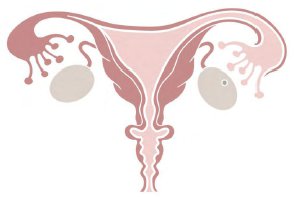You notice a slight abdominal distension, a feeling of bloatedness, clothes fitting tighter around your waist or a persistent feeling of nausea. Chances are you could be experiencing gastrointestinal or bladder conditions, but it could also mean you may be experiencing symptoms of ovarian cancer.

Symptoms of ovarian cancer are not specific to the disease, and they often mimic those of many other more-common conditions, including digestive and bladder problems. When ovarian cancer symptoms are present, they tend to be persistent and worsen with time. The most common symptoms are back pain, fatigue, bloating, constipation, abdominal pain and urinary urgency. Most often these symptoms do not indicate ovarian cancer. However, if you experience them you should discuss them with your doctor.
Symptoms of Ovarian Cancer:
- Abdominal distension, swelling, bloatedness, or clothes fitting tighter around your waist
- Abdominal mass
- Abdominal pain or pressure
- Changes in menstruation
- Loss of appetite or quickly feeling full
- Persistent indigestion, gas or nausea
- Unexplained changes in bowel habits
- A persistent lack of energy
- Changes in bladder habits, e.g. a frequent need to urinate
- Pelvic discomfort or pain
- Low back pain
Ovarian cancer is currently the second most common gynaecological malignancy in Singapore and a rapidly growing problem throughout Asia. It is the most lethal of all gynaecological cancers. A steady increase has been observed in Singapore over the past three decades and ovarian cancer now surpasses cervical cancer in prevalence2. Global cancer statistics indicate that 204,000 new cases of ovarian cancer are diagnosed annually and more than 125,000 women die from this disease3.
What is Ovarian Cancer?
Ovarian cancer is a type of cancer that affects the ovaries in women. An ovarian cyst contains fluid that collects inside an ovary. Many of these cysts are harmless or benign (not cancerous). The fluid will most often be absorbed and the cyst will go away in time without any treatment. However, some will not go away or may get larger4. Ovarian cysts which are malignant are cancerous and known as ovarian cancer. A malignant ovarian tumour can shed cancer cells which may spread to other organs in the body.
Three basic types of ovarian tumours:
- Most common is epithelial tumours. 90% of all ovarian cancers are epithelial. These tumours form in the tissue covering the ovary.
- Germ cell tumours. These tumours occur in the egg-producing cells of the ovary and generally occur in younger women.
- Stromal tumours. These tumours develop in the oestrogen- and progesterone-producing tissue that holds the ovary together.
Ovarian cancer is known as the silent killer because its symptoms are so vague. Usually, at the time of diagnosis, 3 in 4 women will present beyond the early stages of the disease. What this means is cancer would have already spread beyond the ovaries into the abdomen and other organs. In later stages, such as stage III and IV, only 30% of women can survive beyond 5 years. If the cancer is detected early, more than 90% of women can survive beyond 5 years.
Ovarian cancer staging
- Stage I ovarian cancer means the cancer is completely inside the ovaries, or just on the surface
- Stage II means the cancer has grown outside the ovary or ovaries, but is within the area circled by the hip bones (the pelvis)
- Stage III means the cancer has grown outside the pelvis into the abdominal cavity or there is cancer in the lymph nodes in the upper abdomen, groin or behind the womb
- Stage IV means the cancer has spread into other body organs such as the liver or lungs (if there is cancer on the surface of the liver but not within the liver itself, then the cancer is still stage 3)
Ovarian Cancer Risk Factors
About 1 in 71 women may be expected to contract ovarian cancer in their lifetime. Certain factors may increase your risk of ovarian cancer. Having one or more of these risk factors doesn’t mean that you’re sure to develop ovarian cancer, but your risk may be higher than that of the average woman.
These risk factors include:
- Inherited gene mutations. A small percentage of ovarian cancers are caused by an inherited gene mutation. The genes known to increase the risk of ovarian cancer are called breast cancer gene 1 (BRCA1) and breast cancer gene 2 (BRCA2). Women with these mutations have a significantly increased risk of up to 40% to developing ovarian cancer. Another known genetic link involves an inherited syndrome called hereditary nonpolyposis colorectal cancer (HNPCC). Women in HNPCC families are at increased risk of cancers of the uterine lining (endometrium), colon, ovary and stomach.
- Family history of ovarian cancer. If women in your family have been diagnosed with ovarian cancer, you have an increased risk of the disease.
- A previous cancer diagnosis. If you’ve been diagnosed with cancer of the breast, colon, rectum or uterus, your risk of ovarian cancer is increased.
- Increasing age. Your risk of ovarian cancer increases as you age. Ovarian cancer most often develops after menopause, though it can occur at any age.
- Never been pregnant. Women who have never been pregnant have an increased risk of ovarian cancer6.
- Ethinicity – In Singapore, this is one of the few cancers for which Malays have a higher risk (on average 10-20% higher) than Chinese7.
- A woman who has any of the above risk factors should pay close attention for ovarian cancer symptoms and explore early detection options.
Early Detection is Key to Survival
Early stage ovarian cancer is difficult to detect. Often, it is detected in the course of other investigations. If detected early, the survival rate is greater than 90%, compared with only 30% survival in late stage disease. Symptomless ovarian cancer is most often detected during a woman’s regular gynecological examination. Your physician will palpitate your ovaries during your pelvic and rectal exam for the presence of ovarian cysts or fibroid tumors. If any abnormalities are noted, follow up with further testing which may include an ultrasound and CT scan will be recommended. If further testing is required, a laparoscopy may be performed.
Written by Reeta Sabnani, INEX Pte Ltd.
References:
1. hpb.gov.sg/diseases/article.aspx?id=596
2. nccs.com.sg/pbcation/canhelp/dec05/focus2.htm
3. Global Cancer Statistics 2002
4. cancer.org/cancer/ovariancancer/overviewguide/ovarian-cancer-overview-what-is-ovarian-cancer
5. plannedparenthood.org/health-topics/womens-health/ovarian-cancer-30086.htm
6. mayoclinic.com/health/ovariancancer/DS00293/DSECTION=risk-factors
7. nccs.com.sg/pbcation/canhelp/dec05/focus2.htm
8. womenshealth.about.com/cs/ovariancancer/a/ovarcansilkille.htm
9. Jacobs I, Bast RC (1989). The CA-125 tumor-associated antigen – a review of the literature.
* * * * *
Like what you see here? Get parenting tips and stories straight to your inbox! Join our mailing list here.
Want to be heard 👂 and seen 👀 by over 100,000 parents in Singapore? We can help! Leave your contact here and we’ll be in touch.















































Leave a Comment: